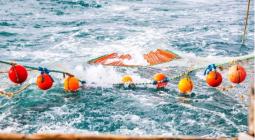‘Hoovered’ up from the deep: 33,000 hours of seabed trawling revealed in protected UK waters
Analysis shows alarming prevalence of harmful fishing methods thought to ‘destroy whole ecosystems’
Industrial vessels suspected of using a harmful fishing method known as bottom trawling spent more than 33,000 hours in British marine protected areas last year, a new analysis of satellite data shows.
Ten of these vessels, primarily from the EU, were responsible for a quarter of this activity in offshore protected areas, according to Oceana UK, a conservation group.
Bottom trawling involves dragging metal gear and heavy nets along the seafloor. It scoops up a high proportion of non-target marine species and has a negative impact on biodiversity.
The two most-trawled sites, according to the analysis, lie off the coast of Cornwall. One is the Western Channel marine reserve, off the Lizard peninsula, composed of underwater sand dunes hosting angler fish and small-spotted catsharks.
The other is South West Deeps (East), 150 miles off Land’s End, which has cuckoo rays, supports seals and whales, and is among the top five offshore marine protected areas (MPAs) for carbon-storage capacity, according to the Marine Conservation Society.
The society estimates that the South West Deeps site has the potential to store 1.7m tonnes of carbon, the equivalent to 1m return flights from London to Sydney. Bottom trawling can release the harmful carbon back into the atmosphere.
Despite the harm the practice is known to do, it is allowed in almost all the UK’s MPAs, designated as sanctuaries to protect rare, threatened or important ocean habitats and species to ensure healthy marine environments.
“Industrial fishing is designed to kill marine life as efficiently as possible,” said Hugo Tagholm, the executive director of Oceana UK.
“Everything from sharks to starfish are hoovered up by bottom trawling, which can destroy whole ecosystems and empty our seas of life. This also threatens communities seeking to make a sustainable living from our seas.
“How can we call them ‘protected’ if we have such highly extractive industries in them? The government must act now to ban this from our marine protected areas.”
Oceana analysed satellite-tracking data from Global Fishing Watch, a nonprofit open-access platform, and found that more than 100,000 hours of apparent industrial fishing took place in MPAs off the coast of Britain in 2023.
A third of this was from vessels carrying bottom-towed gear, such as bottom trawls and dredges. Only 6% of the vessels were from the UK, and the rest were EU ships.
Martin Attrill, a professor of marine ecology at Plymouth University, said it was “astounding” that trawling was still permitted in marine sanctuaries.
“Over a century of industrial bottom trawling and dredging has degraded the UK seabed and still threatens some of our remaining most important and sensitive marine habitats, impacting further the biodiversity and resilience of our seas.”
The UK government, which committed to restricting bottom trawling in MPAs by 2024 after a 2021 legal challenge by Oceana, has been introducing bylaws to protect certain features within sanctuaries, such as reefs, on a site-by-site basis.
It is set to begin a consultation on measures for the majority of England’s offshore MPAs this spring.
A Defra spokesperson said it was focused on stopping damaging fishing activity in all English MPAs. “We aim to have all necessary bylaws in place by the end of 2024, with further restrictions coming into force in 13 areas just this week.”
Four bylaws banning bottom-towed gear were introduced in 2022, covering four MPAs, including Dogger Bank, the largest sandbank in UK waters.
A further bylaw will restrict bottom trawling in an additional 13 marine areas this week followed by a consultation on draft bylaws for the Western Channel MPA and South West (Deeps) East.
Cover photo: A trawler lowers its nets. ‘Industrial fishing is designed to kill marine life as efficiently as possible,’ says Oceana UK. Photograph: Andy Myatt/Alamy








